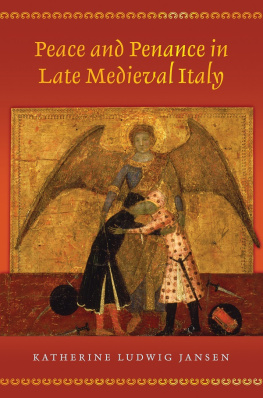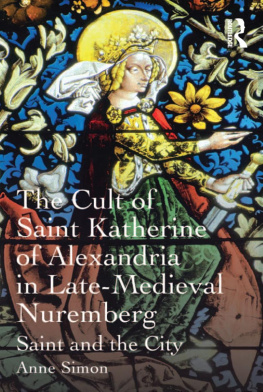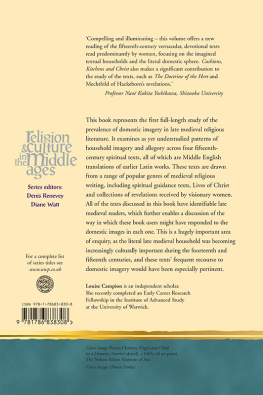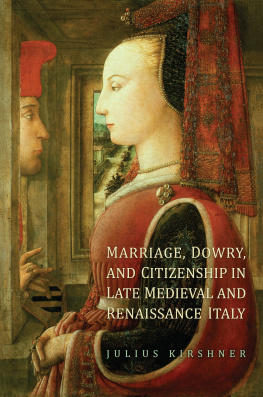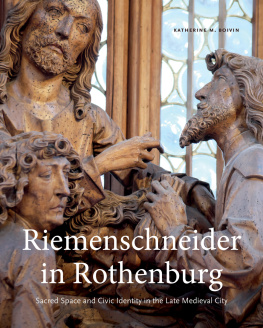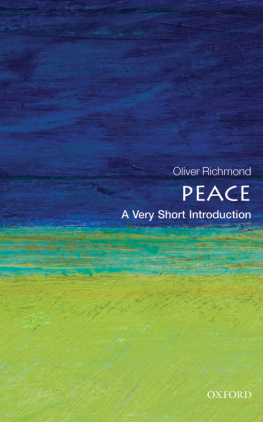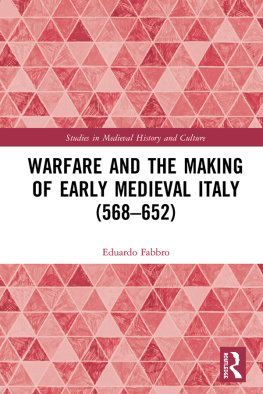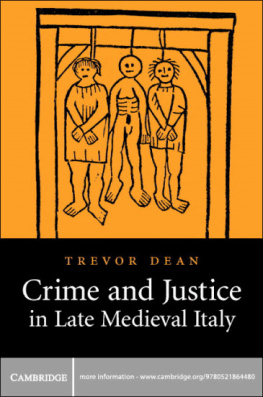
PEACE AND PENANCE IN LATE MEDIEVAL ITALY
Peace and Penance in Late Medieval Italy

Katherine Ludwig Jansen
PRINCETON UNIVERSITY PRESS
PRINCETON & OXFORD
Copyright 2018 by Princeton University Press
Published by Princeton University Press, 41 William Street, Princeton, New Jersey 08540
In the United Kingdom: Princeton University Press, 6 Oxford Street, Woodstock, Oxfordshire OX20 1TR
press.princeton.edu
Jacket illustration: Workshop of Tederigo Memmi. Museum of Fine Arts, Boston. Sarah Wyman Whitman Fund. Photograph 2018 Museum of Fine Arts, Boston.
All Rights Reserved
Library of Congress Cataloging-in-Publication Data
Names: Jansen, Katherine Ludwig, 1957author.
Title: Peace and penance in late medieval Italy / Katherine Ludwig Jansen.
Description: Princeton : Princeton University Press, 2017. | Includes bibliographical references and index.
Identifiers: LCCN 2017035263 | ISBN 9780691177748 (hardcover : alk. paper)
Subjects: LCSH: PenanceHistory. | Peace of mindReligious
aspectsChristianityHistory. | PeaceReligious
aspectsChristianityHistory. | ReconciliationReligious
aspectsChristianityHistory. | Church historyMiddle Ages, 600-1500. | ItalyChurch history.
Classification: LCC BV840 .J36 2017 | DDC 282/.450902dc23 LC record available at https://lccn.loc.gov/2017035263
British Library Cataloging-in-Publication Data is available
This book has been composed in Miller Text
Printed on acid-free paper.
Printed in the United States of America
10 9 8 7 6 5 4 3 2 1
In memory of
Janine Lowell Ludwig (19342012)
and
Fernanda De Vita (19112014)
CONTENTS
| AFH | Archivum Franciscanum Historicum |
| ASF | Archivio di Stato di Firenze |
| BAV | Biblioteca Apostolica Vaticana |
| BS | Bibliotheca Sanctorum |
| CASANAT. | Biblioteca Casanatense |
| CCCM | Corpus Christianorum Continuatio Mediaevalis |
| CCSL | Corpus Christianorum, Series Latina |
| DBI | Dizionario biografico degli italiani |
| MGH | Monumenta Germaniae Historica |
| NOT. ANT. | Notariale Antecosimiano |
| RIS | Rerum Italicarum Scriptores (Milan edition) |
| RIS2 | Rerum Italicarum Scriptores (Bologna and Citt di Castello edition) |
| RLS | Repertorium der lateinischen Sermones des Mittelalters |
| STATUTI | Statuti della Repubblica Fiorentina |
I HAVE RENDERED most names into the Italian vernacular rather than using their Latin form. Thus I use the form Remigio dei Girolami rather than Remigius de Girolamis Florentinus. I have retained the Latin name only when a figure is commonly known by that name; e.g., Jacobus de Voragine, or when his or her place of origin is obscure. The primary exception to that rule is when a name has been Anglicized by tradition; hence Thomas Aquinas. The New Year in Florence began on 25 March, the feast day of the Annunciation. I cite two years for those dates that fall between 1 January and 24 March. Florentine currency and its rate of exchange always present a challenge as rates of exchange varied over time and place. In 1252 when the first gold florin was struck, it was worth one libra or lira (the money of account), which equaled 20 soldi. One lira was worth about one silver pound. The fiorino piccolo (picciolo), or penny (hereafter f.p.), was the Florentine equivalent of the denarius (12 f.p. = 1 soldo/solidus, or shilling). Therefore, 1 lira = 20 soldi/solidi = 240 denari/denarii or fiorini piccoli. See Carlo Cipolla, The Monetary Policy of Fourteenth Century Florence (Berkeley: University of California Press, 1982), viiix.
THIS BOOK has been a long time in the making. During its research and writing I have been the fortunate recipient of generosity from great institutions and individuals alike. It is both a pleasure and a relief to give thanks at last to all of them. Begun in Florence, under the patronage of Villa I Tatti, the Harvard Center for Renaissance Studies, the project also enjoyed support from the American Council of Learned Societies, the Fulbright Foundation, the Grant-in-Aid Program at the Catholic University of America, the Institute for Advanced Study in Princeton and the American Academy in Rome where, high on the Janiculum, I finished the first draft of the manuscript. I am grateful to the selection committees, directors, and staff of these institutions for providing me with funding and periodic intellectual homes over this last decade or so. The resident scholarly communities at the VIT, IAS, and AAR were all memorable groups who, around the lunch or seminar table, allowed me to bounce and refine the ideas that are the foundations of this book.
I am also particularly indebted to the many archivists and librarians at the Archivio di Stato di Firenze, the Biblioteca Apostolica Vaticana, the Berenson Library at I Tatti, the American Academy in Rome, as well as the interlibrary loan personnel at the Firestone Library, Princeton University, the Institute for Advanced Study, and the Mullen Library at the Catholic University of America. In addition, Colum Hourihane and Adelaide Bennett Hagens opened up the resources of Princetons Index of Christian Art to me. Erica Buentello, Beth Newman Oii, Andrew Cuff, Nicolas Novak, and Nicholas BrownCUA research assistants over the yearsalong with Ramon Sola kept pace with my endless requests for books and articles.
I am also grateful to the following institutions for inviting me to speak to engaged audiences who asked the sharp questions that contributed to making this a better book: the American Academy in Rome, Columbia University, Harvard Divinity School, Harvard University, Indiana University, Notre Dame, Princeton University, and Yale University.
By asking the well-posed question, sharing information, or passing on a bibliographical citation, friends, colleagues, and graduate students have provided invaluable inspiration over the years. I am grateful to Frances Andrews, Peter Brown, Barbara Bruderer, Gian Mario Cao, Giles Constable, Natalie Davis, Peter Dougherty, Pat Geary, Jim Hankins, Mchtelt Israels, Rebecca Johnson, Bill Jordan, Carol Lansing, Giuliano Milani, Maureen Miller, John Padgett, Irving and Marilyn Lavin, Bill North, Enrico Parlato, Ken Pennington, John Petruccione, Austin Powell, Louise Rice, Valentino Romani, Dennis Romano, Dan Smail, Franek Sznura, John Van Engen, Michael van Walt van Praag and Chris Wickham. Some of this group also read the manuscript in full or in part and offered valuable comments and criticism. For their collegial generosity and thoughtful feedback, I am indebted to Sarah Rubin Blanshei, Marie dAguanno Ito, Bill Jordan, Dennis Romano, Miri Rubin, Tom Tentler, and the two not-so-anonymous readers at Princeton University Press. Dan Smail, in particular, gave the manuscript the rigorous reading it required. It goes without saying that the mistakes and missteps that remain in the book are of my own making.
In the more than ten years I have spent working on this book, as is the historians prerogative, I have changed my mind and reconsidered my opinions on more than a few topics contained within its pages. Or, as the politicians like to say: my thinking has evolved. This means that I have revised a number of the arguments and corrected mistakes made in various articles I have previously published. I would like to I thank Brill and
Next page
